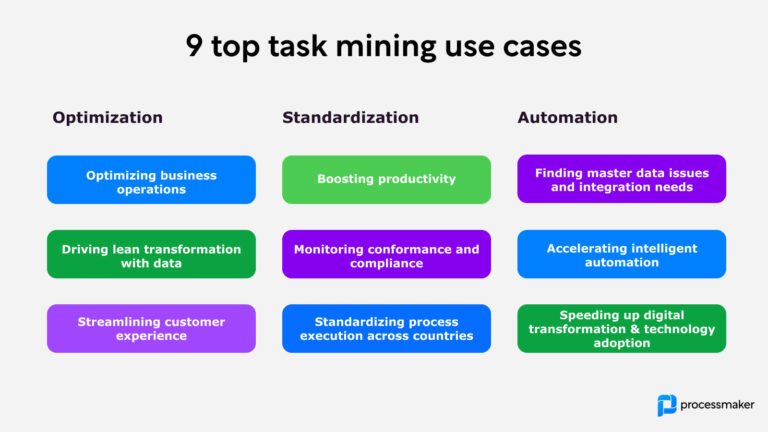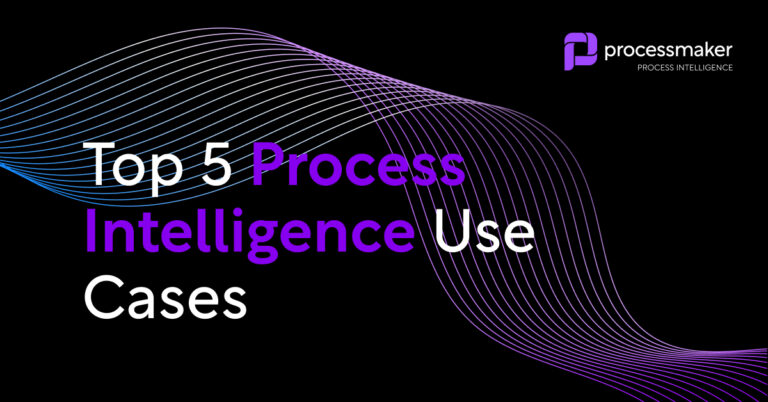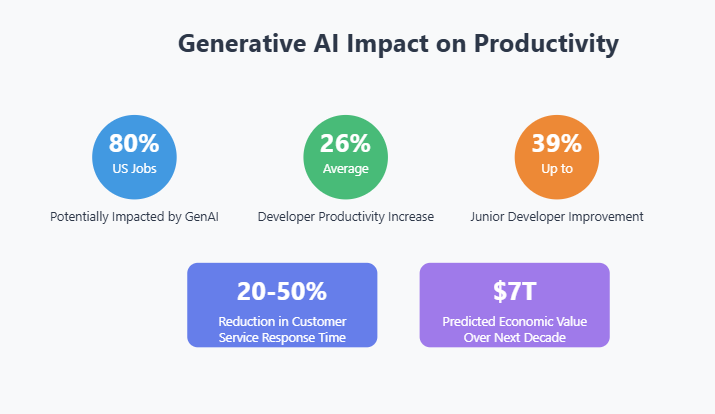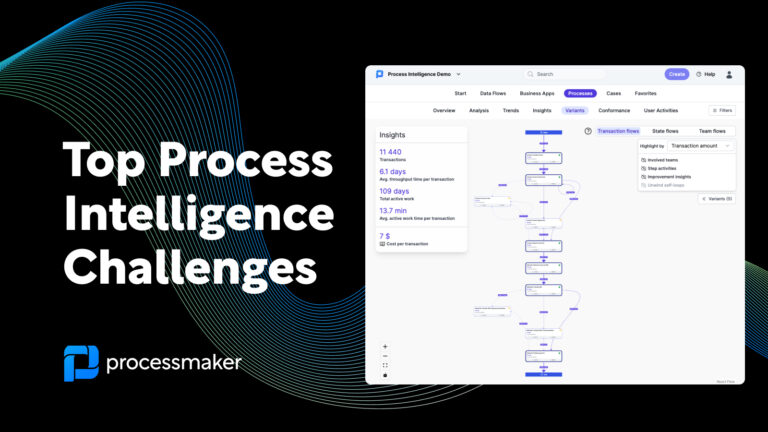According to fresh research by the Everest Group task mining has emerged as one of the fastest-growing areas of intelligent automation software – with investments expected to grow between 75-85% this year.
As many companies look to trial task mining software we evaluate the nine key use cases for taking an object-centric approach to getting benefits from task mining across the enterprise.
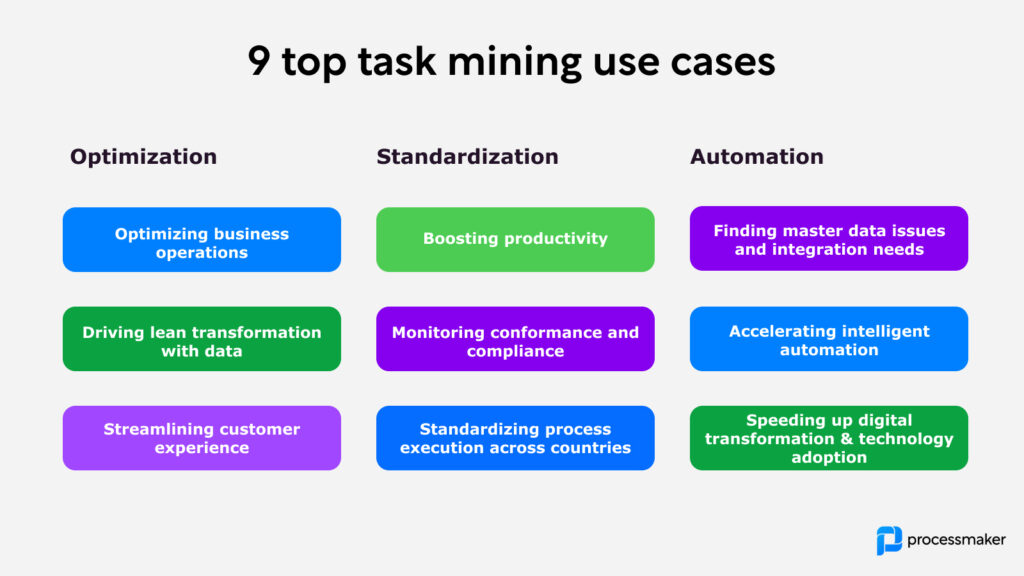
1. Process improvement
Process improvement is the cornerstone of task mining. By delving into user interactions and tasks across business applications, task mining empowers organizations to re-design and optimize the performance of key processes. It offers insights into workflow inefficiencies, enabling the modification of processes to enhance efficiency and overall productivity. This optimization leads to reduced operational costs and improved resource utilization, fostering a culture of continuous improvement and innovation within organizations.
2. Lean transformation
Incorporating task mining in enterprise-wide lean transformation initiatives has enormous benefits. Task mining produces robust data and insights to spearhead the re-engineering of core workflows and processes, eliminating waste and augmenting value. By identifying non-value-adding activities and process deviations, it enables organizations to reallocate resources more effectively, driving optimal value creation and streamlined operational processes, thus aligning organizational operations with lean principles and enhancing overall process agility.
3. Streamlining customer experience
Customer experience is the key driver of many successful businesses. Task mining plays a crucial role in refining customer interactions by connecting the dots of a customer journey across diverse IT systems and approval steps. It offers a cohesive view of customer touchpoints and interactions, enabling organizations to pinpoint areas needing improvement, subsequently enhancing customer satisfaction, loyalty, and overall experience, which are pivotal in today’s competitive business landscape.
4. Productivity boost
Task mining is a catalyst for enhancing organizational productivity. It scrutinizes and identifies bottlenecks hindering productive work, enabling organizations to eliminate these obstructions effectively. Task mining automates mundane tasks and allows employees to focus on more value-driven activities, accelerating task completion, optimizing resource allocation, and significantly enhancing overall workforce productivity, thus contributing to organizational growth and profitability.
5. Compliance monitoring
In the realm of ever-evolving regulatory landscapes, compliance monitoring through task mining can become indispensable. It meticulously tracks the adherence of different teams and business units to agreed-upon processes, ensuring that organizational activities align with regulatory standards. This meticulous tracking mitigates risks associated with non-compliance, enhances process transparency, and ensures that organizational operations are conducted within the legal and regulatory frameworks, fostering a culture of accountability and integrity.
6. Standardization
The role of task mining in process standardization is often overlooked but important. Task mining aligns process execution against a predefined plan, mitigating the need for rework and ensuring uniformity in operational procedures. Standardization facilitated by task mining promotes consistency, reduces variability, and ensures that best practices are adhered to, thereby fostering operational excellence and elevating the overall quality of deliverables.
7. Prove case for digitalization
Task mining lays down the groundwork to quantify master data management challenges and accentuates the need for data integration. It unveils the inefficiencies and redundancies inherent in manual processes, providing tangible insights to justify digitalization initiatives. By highlighting the discrepancies in data management and showcasing the benefits of integrated data systems, it builds a compelling case for the adoption of digital solutions, enhancing data accuracy and accessibility.
8. Advance intelligent automation
Advancing intelligent automation is a pivotal use-case of task mining. It enables organizations to identify and substantiate the business case for automation opportunities, aligning automation initiatives with organizational goals. By automating repetitive and time-consuming tasks, intelligent automation, driven by task mining insights, elevates operational efficiency, reduces errors, and allows human resources to focus on more strategic and creative tasks, thus driving business innovation and growth.
9. Guide digital transformation
Guiding digital transformation is intrinsic to task mining. It measures and amplifies the adoption of cloud-based software and other digital solutions, ensuring organizations stay abreast of technological advancements. It facilitates the seamless transition to digital platforms, enhancing operational agility, scalability, and resilience. By fostering the adoption of advanced technologies, task mining propels organizations towards a future-ready state, ensuring they remain competitive in the digital age.
Bottom line
Task mining emerges as a transformative force in the pursuit of process excellence, providing a multidimensional view of organizational operations. These nine pivotal use cases underscore the versatility of task mining in optimizing processes, enhancing productivity, ensuring compliance, and driving digital transformation. By embracing task mining, organizations are not only addressing their present needs but are also laying a robust foundation for future growth and sustained excellence in an ever-evolving digital landscape.
In a world driven by innovation and continuous improvement, task mining offers a beacon of hope to organizations striving for excellence, acting as a conduit to refined processes, improved productivity, and overall organizational success. The incorporation of task mining is not a mere technological shift; it is a strategic move toward creating a resilient, agile, and future-ready organization.
